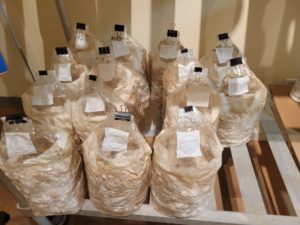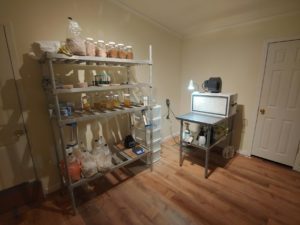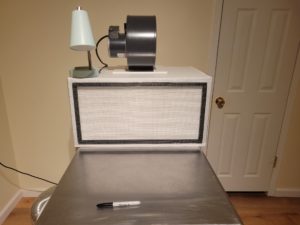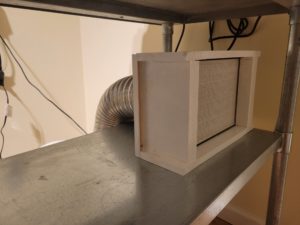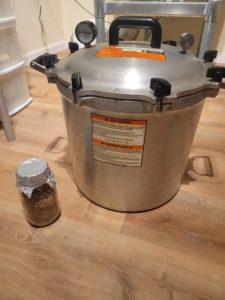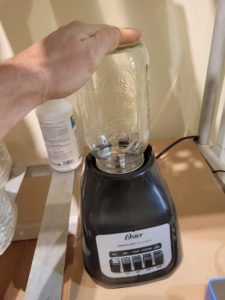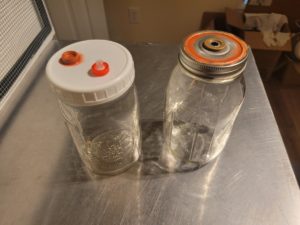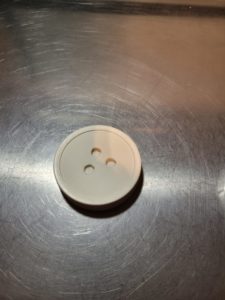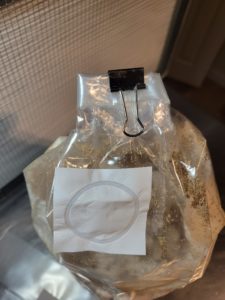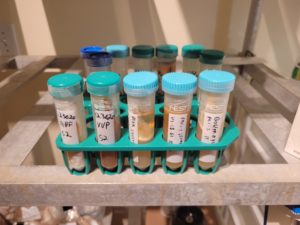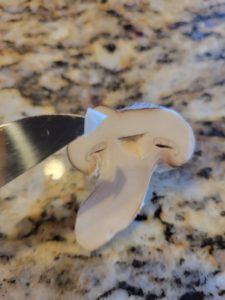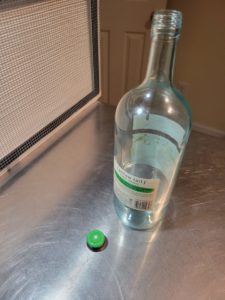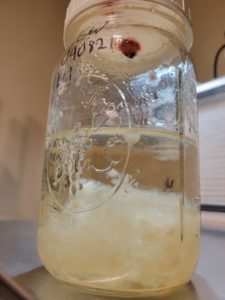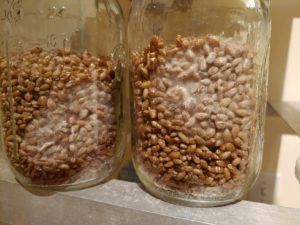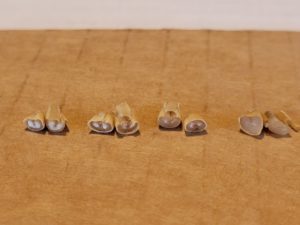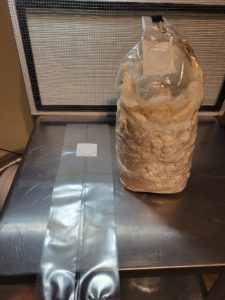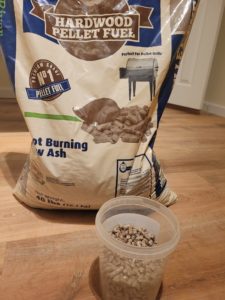This post from Living Web Farms’ Ian Ruckriegel covers the creation of a small-scale mushroom spawn lab and simple methods for making mushroom spawn for use around a small farm. Ian recently led an online workshop covering this same material. A video can be seen here.
My goal here is to give someone that may be new to mycology, yet interested in creating their mushroom spawn an overall understanding and basic toolkit for how it is done. Upon reading, I hope you can walk away from this confident that you understand the process enough to get started on it by yourself.
I’ll cover the basic setup and skills for general mushroom spawn production. I won’t be going over any species-dependent details as any given species will have their own idiosyncrasies that are beyond the scope of what we can cover here.
This is essentially a distillation of what I’ve learned over the years of doing it on my own. I’m not a mycologist nor a professional mushroom farmer but have managed to make a lot of low-cost, good-quality mushroom spawn for cultivation projects around the farm. If I can manage it then I am convinced anyone can, so here is the most straightforward presentation I can give on how I do it. I remember when I first started. It was very confusing and difficult to know where any given piece I was reading about fit into the whole. I hope to alleviate this sense of uncertainty in those who would like to make their spawn for mushroom projects around their small farm or home. It is by no means exhaustive and is a kind of starting point.
Everything mentioned here can be sourced from either a mushroom supply company, hardware store or amazon. These techniques are further focused on small farm situations. That is, somewhere between a home cultivator who might need a single bag of shiitake spawn for a dozen logs in their garden and a dedicated mushroom business who might need hundreds at a time. The simple techniques here are ideal for making several dozen spawn bags at a relatively low cost for a small farmer looking to experiment or make a few hundred mushroom logs.
In the mushroom-growing communities of the internet, many content creators will advise purchasing spawn from a reputable source. This is good advice! If you already have a production system, specific species to cultivate, and a reliable and consistent substrate then it really might make economic sense to outsource your spawn production needs. Outsourcing the spawn process will free up a lot of valuable time that can be better used scaling up your system.
There are, however, many good reasons why you might want to create your own. The unit cost per homemade spawn bag consists mainly of grains and/or sawdust and filter patch bags. This will vary by area and source but is generally between $2-4 per 5# bag compared to the $20-30 per 5# spawn bag purchased from a supplier. This savings can allow you to experiment with new ideas, substrates, and species on a smaller scale. It also allows you to increase the rate of spawn to substrate which generally has a favorable effect on yield and spawn run time. Making your spawn also allows you to clone and grow out species found in your area growing on native substrate sources. This is somewhat analogous to growing an heirloom tomato bred in your specific locale versus a general cultivar offered in a seed catalog. Sometimes this local adaptation can confer real benefits.
The real tradeoff when deciding to purchase or create your spawn comes down to time and initial upfront costs. The equipment and space needed to make your own represents a real cost initially. However, items like an expensive pressure cooker and homemade flow hood will last your whole lifetime and once they are acquired are there to use as you need them. It also has to be said that having a lab like this opens up a whole world of possibilities beyond just spawn production to cloning or even breeding strains and other mycology work.
The four basic steps in the whole endeavor are creating a lab, culturing, expansion, and inoculation. There is a great deal of overlap in these final three steps but I have chosen to divide them here, albeit somewhat arbitrarily, for the sake of conveying a clear approach to the many tasks. Let’s go through each step and touch on the essential skills and ideas of each.
Creating a Lab
Choosing a space is the first step. The space should be as clean as you can manage. Smooth, hard, non-absorbent surfaces that can be sanitized with alcohol are important. Repainting the walls with high gloss white paint would be helpful although not necessary. Any rugs or fabric curtains should be removed. When not in the room it should be pretty close to dark which can be accomplished by blocking the windows with cardboard. The goal here is a clean, as close to sterile as is feasible, dark room with enough space to fit a small shelf and 2’x4’ table. I would say minimum square footage of around 50 sq ft should be sufficient. Almost any spare room with hardwood floors is ideal here. If a spare clean room is not possible a small corner of a basement can work if you make a small plastic mini room within the larger room. In this case, the optional positive pressure box mentioned later becomes more desirable. This need not be a fully dedicated space just for a mushroom lab. It could otherwise be an office or some multipurpose room. It just needs to be easily cleanable before use as a lab and then your little table and flow hood could go back into the closet afterward.
Once you have a clean space for spawn making you will need the following equipment:
Flow hood– the goal of a flow hood is to provide sterile laminar(smooth and not turbulent) air over your workspace thereby preventing contamination. This is essential for any agar-related work. You can buy a pre-made flow hood if you have the money but I would suggest building one as it is significantly cheaper. Purchasing a flow hood can set you back over $1000 while you can build one for less than $500. Building a flow hood is as simple as building an airtight box that uses a fan to force air in and a HEPA filter to clean the outgoing air. Here is a website that can provide a step-by-step DIY. There are many such websites detailing this process and many message boards that provide easy instructions.
The most complicated part is finding a HEPA filter and matching an appropriate fan. A fan too strong will create turbulent air while a fan too weak will not provide enough clean air to sweep the workspace clean. The standard size is 12”x 24” which is ideal for a small lab. The filter should be 99.95% HEPA or 0.3-micron filtration capacity. A 12”x24” 0.3-micron filter will require roughly a 549 CFM fan. Use what’s called a blower or squirrel cage blower and NOT an in-line fan. The in-line fans can create a great deal of oscillation that will vibrate your work surface and things will slowly begin to migrate around the table and eventually fall off. Not fun.
Much of the literature available on the internet include math equations to perfectly match a blower to any filter. Unless you plan on building a novel size or shape flow hood it’s not necessary to torture yourself with the calculations. Here is exactly the filter and blower I and many other people use:
- EAMF2412- 12”x24” 0.3 micron mini pleat HEPA filter from Fungi.com
- Dayton 1TDT2 Blower, 549 CFM, 115V, 2.05 Amp, 1640 RPM
Just get these and build a box. You will know it’s right when you turn it on and hold a lighter about 12” from the face and the flame tilts in the laminar air about 45 degrees.
Positive pressure box(optional)– This is an optional piece of equipment that adds an extra layer of insurance against contamination that I would recommend. It’s essentially a smaller cheaper version of the flow hood that brings air from outside the lab, cleans it with a small HEPA filter, and then pumps it into the lab. This creates a positive pressure in the lab that then pushes cleaner air out of the lab thereby blocking the entry of unclean air. This unclean contaminated air would otherwise be flowing in and out under the door of your lab, or anywhere else that isn’t sealed off to the exterior of the lab, as the barometric pressure and wind conditions change. It also has the added benefit of increasing the life of your much larger and more expensive filter installed on your flow hood.
To build this get a length of 4” ducting and a small 4” inline fan. Rig that to push air into a box whose outlet has a HEPA filter purchased from a home improvement store. They usually have a plethora of these cheap HEPA filters of different shapes and sizes sold as replacements to a variety of air filtration products. Then hook the inlet to the 4” ducting to pull air from outside the lab. This can be from a window, under or through a door, or even through the central air duct. The important part is that the air source is from outside the lab. This need not be large, powerful, or expensive. You should be able to make this for $100 or less and as long as it can get in at least 100 cfm of filtered air it will serve its purpose.
Table– stainless steel preferable, smooth non-porous otherwise. sized 5’x2’ at least. Big enough for the flow hood and a 2’x2’ workspace in front of the flow hood
Pressure cooker– All American brand pressure cookers are the standard for most small-scale mushroom growing They are admittedly scarce since the pandemic hit but be patient and you will find one. Get the biggest All American pressure cooker you can. This will drastically increase your efficiency as how much you can sterilize at a time is often the biggest bottleneck in the whole process. I use an All American 941. This model can fit 16 qt jars at a time or 4-6 spawn bags, which seems to be ideal for this scale. All the following recipes are based on a batch run of each given task in this particular pressure cooker. It can also be used for big canning projects around the farm. These are not cheap but they are well worth the cost in my opinion and very versatile besides our purposes here.
Short of that any large Pressure cooker will do. A minimum volume would probably be at least 15-20 qts of volume. At least enough space to fit two 5# filterpatch bags of grain spawn or 6-7 qt size mason jars. Anything less than that probably wouldn’t be worth your time.
Shelving– Any shelving will do as long as it is both sanitizable and lifted off the ground to protect from rodents. Bags of grain are very tempting to vermin.
Supplies– There are various small items for the lab that can be procured on amazon or any mycology supply store. Here is a list for each step of the spawn making process:
- Culturing
- Petri dish, 110 mm, sterile and wrapped in packs of 10-20
- Centrifuge tube, 50 ml, sterile and wrapped in packs of 25 a with holding rack
- Scalpel
- Alcohol lamp with denatured alcohol
- Parafilm 2”x250’
- Screwcap Wine bottle with filter lid (poke a hole in the lid and fold up some Tyvek underneath)
- Latex Gloves
- Surgical masks
- Tyvek suit
- LC lids, polypropylene wide mouth mason jar lids with a filtered air port and self-sealing injection port installed with silicon glue(optional, for LC)
- Cheap Oster blender, (optional, for LC)
- Syringe, (optional, for LC)
- Expansion
- Narrow mouth qt jars
- 70 mm mason jar lids, autoclavable
- 70 mm filter discs
- Inoculation
- Filter patch spawn bags, sized 22.5 x 8.25 x 4.75 inches, .3 micron filter patch
- Medium binder clips, for securing the bags
Assemble the above items in your new workspace. The arrangement of everything in the lab affects your work. Place the flow hood and work table on the opposite end of the room from the door with the storage rack between. If you are using a positive pressure box place its outlet underneath or to the side of the work table facing the door. This will create a pressure gradient that will constantly sweep toward, and eventually underneath, the door making for an upstream fight for contaminants. Have your tools and items to be used either beside or behind you while you work. Nothing should be beyond the flow hood or be able to shed any contaminants into your sterile laminar air.
As you work through the subsequent steps it is important to hold some ideas in mind. Just as the arrangement of your lab is important, the positioning of items and workflow while in front of your flow hood affects the risk of contamination. Agar and other items sensitive to contamination need to be placed directly in front of the flow hood while working. Do not place tools or grain jars in between the flow hood and a petri dish for instance, as this is an opportunity for a contaminant to jump from a less clean item into the agar of your petri dish via the stream of clean air coming from the flow hood. Like the room as a whole, there is a gradient of cleanliness in the area between where you stand and the face of the flow hood. The risk of contamination increases as you move either farther from the flow hood face or behind any object introduced onto the laminar air, like your hand or mushroom specimen you intend to clone. Arrange items in your workspace accordingly to control the risk of contamination.
Staying clean is very important in the lab generally. Before any session in the lab, I turn on my flow hood and positive pressure box for an hour or so to clean up the air, take a shower and then go directly to my lab and suit up in a Tyvek suit, mask, and gloves. I then spray the air and work surface with a fine alcohol mist. Work deliberately and smoothly while in your lab and use the alcohol flame to sterilize your scalpel or knife, heating it in the flame until it is red hot in between cuts
A quick word about temperatures: Many mushrooms have a preferred temp they like to grow at and most sources concern themselves a great deal with incubation temps. I find this can mostly be ignored as most all fungi grow well at room temp with only a few exceptions. If anything you would do well to keep your lab space a little cooler as I have noticed higher temperatures seem to promote contamination. I store almost all of my cultures in the fridge; except for Volvariella, almond portobello, and pink oysters that like warmer temps which I store in the lab at room temp. Don’t let your lab freeze or get too hot in the summer and you can mostly not worry about temperature.
Culturing
The overall goal in the culturing step is to store a young cell line free of contamination and have it ready to expand for the next step. The substrate, or material we will be growing the mycelium on, is agar that has been congealed in either a petri dish or test tube. Sterility is important at this stage as any contamination will only be amplified from here on out.
The idea of a young cell line is an important one that needs some explaining. I am sometimes asked if you can go to the grocery store and clone a mushroom you like there and use it for cultivation. The simple answer is yes. You wouldn’t want to use that for any serious spawn production, however, as a culture made from a store-bought mushroom would be prone to senescence and therefore lack the vigor necessary for the mushroom growing process. The more a mycelial network expands the more it ages and a commercial mushroom operation will have already expanded its cell line greatly during the growing process.
Always have a bank of cells from which you can call upon for the expansion phase of the spawn production. This bank is generally kept in what’s called a culture slant. This is a test tube that has been filled with warm agar and then tilted during cooling so that the surface of the agar runs diagonal lengthwise of the tube. I always have at least two slants of each strain I have and they can be stored in the fridge, lid wrapped in parafilm to allow for a modicum of gas exchange, and placed into a plastic bag. Stored this way a culture can last for years.
Buying a culture slant is the absolute best way to get started with an established strain of fungi. A culture slant will already be a sterile, relatively young cell line in an easily stored container. Most spawn purveyors sell pure culture slants for between $30 and $90. Considering you can turn that small purchase into literally thousands of bags of spawn retailing for around $20 a piece that’s a great deal! Now that you have built your lab you are ready to do just that.
Cloning specimens is the other great way to get a culture in hand. Whenever I see a good mushroom specimen fruiting plentifully in the wild I grab one, clone it and add it to the library. To clone you will need a young fruitbody that is as free of bugs and dirt as can be managed. You will then need to grab a clean petri dish and head to the lab.
- Place the plate directly in front of the flow hood and the mushroom farther back from the plate.
- Break open the cap of the mushroom and cut out a small 3-5 mm size chunk from the white tissue above where the stem meets the cap. Place this in the center of the plate.
- Parafilm, label, and date the plate. Wait 10-20 days for the mycelium to fully colonize the plate.
- Then a small piece of agar from the cleanest part of the plate, between the initial mushroom tissue and outermost rim of mycelial growth, can be cut out and placed in a culture slant to colonize.
You now have a purified culture to create your spawn from. In this way, interesting and potentially useful strains are saved from the wild. Many popular commercial strains started life by being cloned from wild specimens.
Working with agar is one of the least forgiving areas of this whole process. It must be sterilized to protect from contamination and once sterilized can not come in contact with anything unsterile or it will be ruined. When in the lab anything with agar should be as close to the face of the flow hood as possible
Creating agar slants and plates is simple:
- Agar ingredients should be mixed according to the recipe and placed in a wine bottle with a filter lid and sterilized at 15 psi for 20 min. (Do not let the pressure release on the pressure cooker go off as the agar can boil out of the bottle and be ruined)
- Once the sterilization cycle is complete, turn off the heat and place the pressure cooker, fully sealed, in your lab.
- Allow it to cool to about 120 F before opening the pressure cooker and starting to pour. Agar congeals around 110 F so you must work quickly and pour the whole bottle before it sets.
- If pouring slants, fill the tubes in the rack, put the caps back on the tubes, and tilt the whole rack about 30 degrees while cooling.
- If pouring petri dishes, stack them in stacks of ten after filling and put mason jars of hot water on the top dish to prevent condensation from forming in the dishes as they cool.
Unused slants and dishes should be sealed in plastic bags and stored in the fridge where they will last for many months.
MYA Agar Plate Recipe (Yields 20 each 110 mm petri dishes or 25 each 50ml slants )
.5 L water
10 g agar
10 g malt
1 g yeast
.5 g peptone
PMYA Agar Plate Recipe (Yields 20 each 110 mm petri dishes or 25 each 50ml slants )
.5 L water from a pot of boiled potatoes
10 g agar
5 g malt
1 g yeast
.5 g peptone
PDYA Agar Plate Recipe (Yields 20 each 110 mm petri dishes or 25 each 50ml slants )
.5 L water from a pot of boiled potatoes
10 g agar
5 g dextrose
1 g yeast
.5 g peptone
Another important consideration when working with agar is to alternate recipes for each batch of agar. If a strain grows on the same substrate for too long then senescence can begin to set in earlier than necessary. By forcing the fungi to adapt to new agar substrates you can essentially keep it young and vigorous. I usually just rotate between the above three recipes.
Once you have a culture slant fully colonized and contaminant-free it’s time to start making transfers. This is done by:
- Quickly remove a piece of myceliated agar from the slant and place it in the middle of a clean petri dish.
- Seal petri dish with parafilm, label, date, and allowed to fully colonize.
- Repeat with further expansions from the above dish to yet more petri dishes to obtain the desired number of dishes.
I generally get 8 qt jars of grain per petri dish. If you plan on starting the expansion phase with liquid cultures then you will only need one fully colonized petri dish as each dish creates one 500 ml jar of liquid culture.
A further step can then be taken to make a Liquid Culture(LC) which is essentially agar from a petri dish that has been blended in water. The mycelium is then allowed to grow for some time while occasionally being agitated. The agitation breaks up the mycelial mat producing millions of small stellate mycelial forms allowing for rapid colonization of the grains during the expansion phase.
Liquid cultures are not necessary to do but I do recommend it for fast-growing vigorous mushroom species like oysters or Ganoderma. The drawback to liquid cultures is that any contamination that takes hold can then go on to ruin many jars of grain. Many types of contamination, however, can be visually ascertained in the LC jar before use, although some cant. I like LC because for the right species like oysters I rarely have had contamination and I can get a single petri dish to inoculate 50+ grain jars. The LC can also be kept at the ready for months. At the beginning of spring, I make a few jars of LC and have those ready to spin up oyster spawn quickly whenever I eye a good substrate to grow oysters on.
Making the LC is very simple:
- Sterilize one narrow-mouth qt jar with 500 ml water and 5 g honey, a narrow-mouth lid with Oster blender blades fitted, and a wide-mouth qt jar with LC lid and marble for 20 min at 15 psi.
- Take a fully colonized petri dish and put it into the narrow-mouth water/honey qt jar with the blender blade lid and blend for three 2 second pulses.
- Pour the liquid into the wide mouth mason jar with marble and LC lid.
- Allow the mycelium to grow for at least a week into the water. Agitate for 30-60 seconds each day for the first week of growth and before use to keep the mycelium from forming a solid mat.
Liquid Culture recipe:
1 wide-mouth quart jar with LC lid and marble
1 narrow mouth qt jar with blender lid
1 fully colonized petri dish with desired strain
500 ml water
5 g honey
LC is that simple. 5-10 ml of the liquid is then drawn out and squirted into qt jars of grain for the expansion phase. If using an aggressive fungus these jars will colonize markedly faster than simply using an agar wedge thus speeding the whole process along. You can also make 50-80 qt jars per jar of LC. Be observant of your LC, however, as contamination can grow quickly. The liquid should stay clear other than the clouds of mycelium growing within. If the water looks turbid, particularly before agitating the culture, it most likely has a bacterial bloom and will have to be thrown away. Any mycelium not opaquely white will most likely be mold and also make it useless.
Expansion
Now that you have a clean young cell line cultured on a petri dish or LC it is time to expand the mycelial network on qt jars of grain before inoculating your final spawn bag. Grain is the substrate of choice here even if your final product is sawdust spawn. Each grain will become an energy-rich base camp for the mycelial network to boom through your final spawn material. For this step, I use exclusively narrow mouth quart jars with filter patch lids. These lids are simple to make and can be reused indefinitely.
Working with grains is fairly simple and most can be used from wild bird seed to rye to wheat. I highly recommend using whole oat grains as the main grain for almost all your needs. These are cheap and easy to get at an animal feed store. Make sure to get the kind still in the woody hull as these are most resistant to contamination and fungi specialize in the use of this woody outer layer. They are also the least resistant to bursting during cooking, which I will cover shortly. Each qt jar requires 1 c uncooked oats and each 5# grain spawn bag will need 1 qt uncooked oat grain.
Preparing grains:
Grain Prep (yields 16 qt jars grain spawn)
4 qts whole oats
3 gal water
2 T gypsum
- Rinse the appropriate quantity of grains thoroughly until the water runs clear.
- Place grains in a large pot with plenty of water and bring to a low simmer for 10-14 min, or until the endosperm has just a speck of uncooked starch remaining. ( a good indicator that the grains are done is you will start to see burst granules. Be mindful of these burst granules as too many can be conducive to contamination. A few are fine but a lot means you have overcooked the grains.)
- Strain grains and lay them out on a large table in a thin layer overnight or until there is no excess moisture on the surface of the grains. ( If you proceed with too much excess moisture you will be asking for bacterial contamination, more on that later. A good litmus to use is to place a tablespoon of grains on a piece of toilet paper. If the grains make the toilet paper wet then they are too wet, leave them to dry for longer.)
- Once they are dry on the surface load a pint at a time into regular mouth qt mason jars. Do not fill each jar more than halfway as you will need space to shake the jars halfway through colonization.
- Place filter lids on each jar, top each with aluminum foil and load them into the pressure cooker.
- Run your pressure cooker at 15 psi for 2 full hours.
- Allow to cool and bring the whole pressure cooker into your lab for inoculation.
- Inoculate grains in front of flow hood
- If you are starting from a petri dish culture then cut your agar in 8 wedges like a pizza and drop one wedge per jar while working in front of your flow hood.
- If you are using an LC, then pull out the liquid with a syringe through the injection port and squirt 5 ml of liquid per jar and shake.
- Once inoculated allow the jars to fully colonize for 10-18 days at room temperature. Halfway through, when you notice the mycelium has colonized 15-20% of the volume of the grain vigorously shake and turn the jars. This fully redistributes the mycelium and breaks it up drastically speeding up the colonization process.
The growth in the jars should be mostly uniform, complete, and with a few exceptions all white. Any other colors could mean contamination. Any wet-looking grains that haven’t fully colonized or foul smells will also indicate contamination. If you have set up a clean lab and are using a flow hood, though, contamination should be very rare. Once you have fully colonized grain jars that smell mushroomy you are now ready to make your spawn bags.
Inoculation
The Inoculation phase is the last phase of spawn making. This step entails taking the expansion phase grain qt jars of mycelium and inoculating our final spawn bags. Here we have a choice of final spawn material. We can use grain spawn for a final product or we can use sawdust spawn for our final spawn material. This choice depends on the type of mushroom we want to grow, and in some cases, we could choose either/or as in the case of oyster mushrooms. The decision for the final spawn type is somewhat of a separate discussion so here I will simply go over simple techniques for creating both and allow you to choose as the situation dictates.
The final spawn bag will be in whats known as a filter patch bag. I prefer to use a larger-sized bag of roughly 22.5 x 8.25 x 4.75 inches. The reason for this is I like to inoculate each spawn bag with a quart jar of grain and want to get the biggest bang per quart jar. Keep in mind that you can inoculate two small spawn bags with each quart jar of grain if you want.
To secure these bags once filled most spawn producers use an impulse sealer to fully close the bags. I find this unnecessary when producing for your purposes. Simply fold the open end down a few times, then fold it together from each side and secure with one of those big black binder clips. This works great and the clips can be reused indefinitely.
Creating grain spawn bags is the same process as during the expansion phase, you’re just putting the grains in the filter patch bag instead of the mason jars. Once the grains are properly cooked and dried load each spawn bag with grains and fold down the top of each bag in a pleat style. Stack them in your pressure cooker and sterilize for 2 hours at 15 psi. Once cooled bring the pressure cooker into your lab and inoculate in front of your flow hood.
Grain Prep (yields 4 each, 5# grain spawn bags)
4 qts whole oats
3 gal water
2 T gypsum
Creating sawdust spawn bags is simpler and more scalable than grain spawn bags. Grain spawn being very nutrient-rich means you must sterilize the grains and carry out the inoculation phase in a sterile setting. Sawdust spawn is a different matter. You can get away with rough pasteurization and inoculation anywhere with sawdust. This means you aren’t hindered by the number of bags you can pressure cook at any given time. So if I can get away with sawdust spawn then that is my go-to spawn type
The secret to quick and easy sawdust spawn is to go to the hardware store and buy hardwood fuel pellets. These are cheap and plentiful throughout the country. One $4 bag of fuel pellets weighing 40# can yield 18-20 5# sawdust spawn bags. The bag must say it is hardwood explicitly and not conifer, as conifer is not appropriate for most mushroom cultivation.
To make sawdust spawn:
Sawdust Prep (yields 4 each, 5# sawdust spawn bags)
4 qt hardwood fuel pellets
4.5 qts boiling water(36 oz per bag)
Pinch of gypsum per bag
- Turn your oven on to 160 F and allow it to preheat. Pull the racks out except the bottom-most rack. (The bottleneck here is the number of bags you can fit in your oven. In my oven I can fit 12 bags so I will do a 3x of the recipe below.)
- Fill each spawn bag with a qt of pellets and a pinch of garden gypsum while your water comes to a boil.
- Once all are filled and water is boiling turn your oven off and CAREFULLY pour 36 oz of boiling water into each bag. Use oven mitts to protect against the heat and roll around each bag to evenly distribute the water as the pellets fully expand into sawdust.
- Fold down the top of each bag and quickly stack each bag in the oven. Once the oven is stacked full of how bags the oven will stay above 140 F for many hours. This constitutes effective pasteurization.
- After the bags have cooled to room temp, take them out and pour in your quart jars of grain.
- Roll them around evenly distributing the grains within the sawdust.
- Fold down the top few inches of the bag above the filter patch and clip with a binder clip.
- Allow your Inoculated spawn bags to fully colonize. No need to shake or disturb these bags to speed it along, just focus on evenly distributing the grains into the spawn bags and you will get lightning-fast colonization in 7-14 days.
Once done these bags can store for several months in a cool dark place like a fridge awaiting their use. I generally make large batches of each type of mushroom I want to grow at the beginning of both fall and spring and then have them ready for use throughout their respective season.
Creating your spawn is as straightforward as is shown here and once you run through this process on your own a few times it will seem easy from then on. There are many books and resources available to help hone your techniques. I recommend Tradd Cotter’s book Organic Mushroom Farming and Mycoremediation as well as Paul Stamets’ Growing Gourmet and Medicinal Mushrooms. It will take some time and money to put together your lab but once it is in place it will be a resource that pays dividends. Having a lab like the one detailed here opens up a mycological world of possibilities and I encourage everyone to invest in their ability to make your spawn.
